Different Types of Industrial Carts and Their Utility

Industrial carts are essential material-handling tools designed to transport goods, components, and equipment safely and efficiently within warehouses and manufacturing plants. They come in a variety of configurations to suit different loads, floor surfaces, and work environments. By reducing manual lifting and carrying, these carts help prevent workplace injuries, streamline workflows, and boost overall productivity.
Choosing the right cart type depends on various factors, including load weight, frequency of use, floor conditions, and other relevant considerations. Here are five common types of industrial carts.
Steel Platform Carts
Built from heavy-gauge welded steel, platform carts provide a flat, rigid deck capable of supporting extremely heavy loads. Their solid construction resists deformation and damage from impacts, making them ideal for harsh industrial environments.
These carts excel at moving pallets, drums, machine parts, and assemblies between workstations or shipping areas. With minimal maintenance and a long service life, steel platform carts offer a low total cost of ownership.
Plastic Utility Carts
Plastic utility carts, fashioned from high-density polyethylene or polypropylene, resist corrosion, chemicals, and moisture while remaining surprisingly lightweight. They typically handle loads up to 400–600 kg without adding excessive dead weight to the cart itself.
Smooth, non-porous surfaces make them easy to clean and sanitize, which is especially valuable in food processing, pharmaceutical, and clean-room settings. Molded shelves or baskets prevent small items from slipping, and optional raised lips help contain spills. Equipped with non-marking polyurethane casters, they glide quietly over tile, concrete, or epoxy floors.
Pneumatic-Tire Platform Carts
Pneumatic-tire platforms are air-filled or semi-pneumatic wheels that absorb shocks and roll smoothly over uneven or outdoor terrain. These carts bridge the gap between indoor warehouse floors and exterior staging areas, handling debris, cracks, or gravel with ease.
By reducing vibration transfer to the operator, pneumatic-tire carts help minimize fatigue during long hauls. Integrated braking systems—either foot-activated or hand-lever—lock the wheels securely during loading and unloading. Their versatility makes them indispensable for facilities that need seamless material transfers between indoor and outdoor environments.
Motorized Industrial Carts
Motorized industrial carts leverage onboard batteries and electric motors to automate the movement of heavy loads without manual pushing or towing. With capacities ranging from 1,000 to over 10,000 kg, they can tow trailers, reposition machinery, or transport skid racks across large facilities. Ergonomic controls—such as variable-speed drives, dead-man safety switches, and adjustable handlebars—allow precise maneuvering in tight spaces.
Regenerative braking and energy-efficient motors extend battery life, lowering operating costs over time. By maintaining consistent speeds and reducing physical strain on workers, these carts boost throughput on repetitive routes. They’re ideal for high-volume operations where speed, safety, and minimizing fatigue are critical.
Specialty Drum Carts
Specialty drum carts are engineered for safe handling and transport. Cradles, straps, or clamp mechanisms secure barrels upright, preventing spills during movement. Some models include tilting mechanisms or hand-crank rotators for controlled pouring or dispensing of liquids and powders. Pneumatic or semi-pneumatic casters ensure smooth rolling, even under full drum loads.
By combining containment with mobility, drum carts dramatically reduce manual lifting and spill risks in chemical plants, laboratories, and maintenance shops. Their design enhances both operational efficiency and compliance with safety regulations.
These were some of the most common industry carts used across industries.



